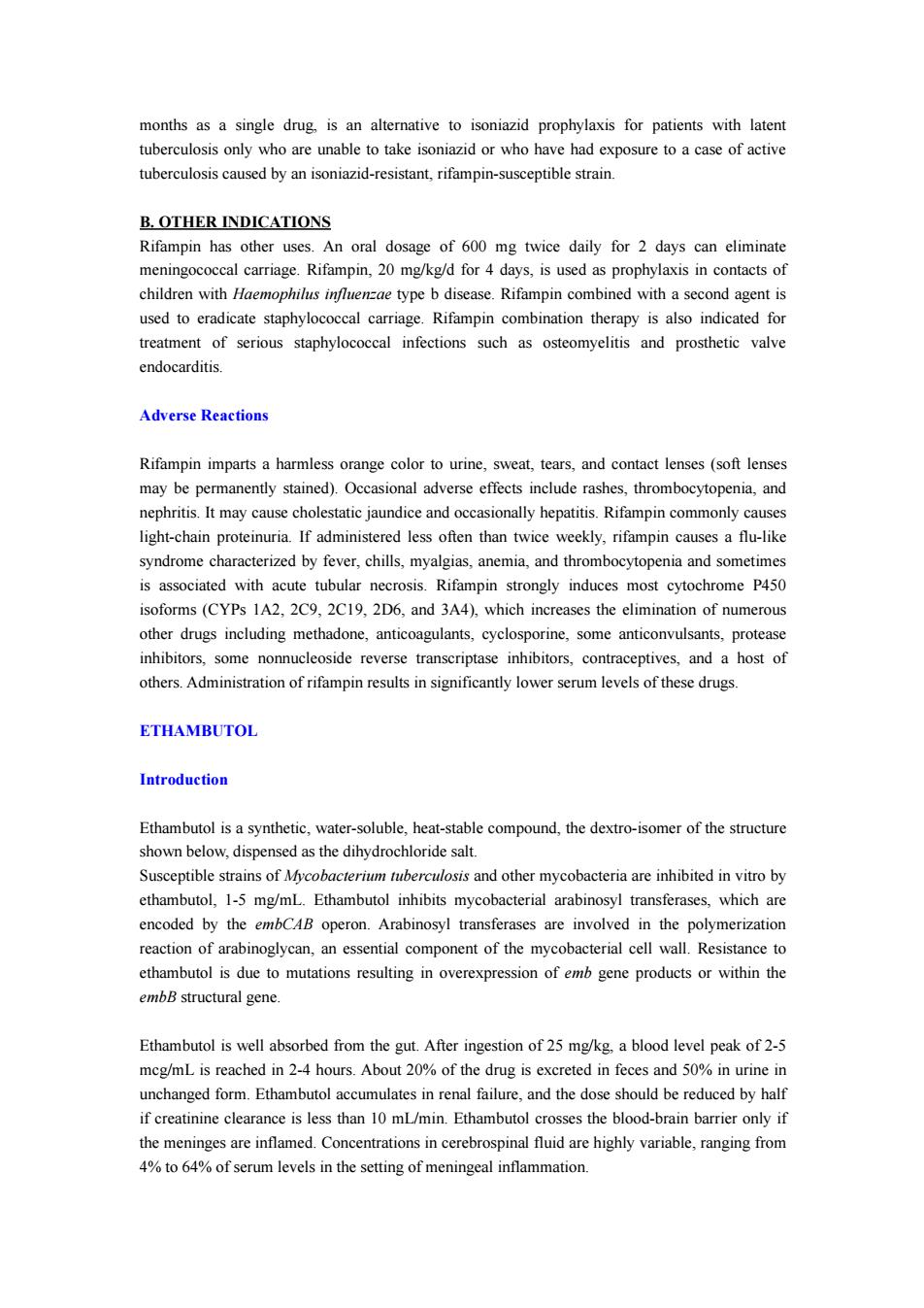正在加载图片...

months as a single drug,is an alternative to isoniazid prophylaxis for patients with latent tuberculosis only who are unable to take isoniazid or who have had exposure to a case of active tuberculosis caused by an isoniazid-resistant,rifampin-susceptible strain. B.OTHER INDICATIONS Rifampin has other uses.An oral dosage of 600 mg twice daily for 2 days can eliminate meningococcal carriage.Rifampin,20 mg/kg/d for 4 days,is used as prophylaxis in contacts of children with Haemophilus influenzae type b disease.Rifampin combined with a second agent is used to eradicate staphylococcal carriage.Rifampin combination therapy is also indicated for treatment of serious staphylococcal infections such as osteomyelitis and prosthetic valve endocarditis. Adverse Reactions Rifampin imparts a harmless orange color to urine,sweat,tears,and contact lenses (soft lenses may be permanently stained).Occasional adverse effects include rashes,thrombocytopenia,and nephritis.It may cause cholestatic jaundice and occasionally hepatitis.Rifampin commonly causes light-chain proteinuria.If administered less often than twice weekly,rifampin causes a flu-like syndrome characterized by fever,chills,myalgias,anemia,and thrombocytopenia and sometimes is associated with acute tubular necrosis.Rifampin strongly induces most cytochrome P450 isoforms(CYPs 1A2,2C9,2C19,2D6,and 3A4),which increases the elimination of numerous other drugs including methadone,anticoagulants,cyclosporine,some anticonvulsants,protease inhibitors,some nonnucleoside reverse transcriptase inhibitors,contraceptives,and a host of others.Administration of rifampin results in significantly lower serum levels of these drugs ETHAMBUTOL Introduction Ethambutol is a synthetic,water-soluble,heat-stable compound,the dextro-isomer of the structure shown below,dispensed as the dihydrochloride salt. Susceptible strains of Mycobacterium tuberculosis and other mycobacteria are inhibited in vitro by ethambutol.1-5 mg/mL.Ethambutol inhibits mycobacterial arabinosyl transferases,which are encoded by the embC4B operon.Arabinosyl transferases are involved in the polymerization reaction of arabinoglycan,an essential component of the mycobacterial cell wall.Resistance to ethambutol is due to mutations resulting in overexpression of emb gene products or within the embB structural gene. Ethambutol is well absorbed from the gut.After ingestion of 25 mg/kg,a blood level peak of 2-5 mcg/mL is reached in 2-4 hours.About 20%of the drug is excreted in feces and 50%in urine in unchanged form.Ethambutol accumulates in renal failure,and the dose should be reduced by half if creatinine clearance is less than 10 mL/min.Ethambutol crosses the blood-brain barrier only if the meninges are inflamed.Concentrations in cerebrospinal fluid are highly variable,ranging from 4%to 64%of serum levels in the setting of meningeal inflammation.months as a single drug, is an alternative to isoniazid prophylaxis for patients with latent tuberculosis only who are unable to take isoniazid or who have had exposure to a case of active tuberculosis caused by an isoniazid-resistant, rifampin-susceptible strain. B. OTHER INDICATIONS Rifampin has other uses. An oral dosage of 600 mg twice daily for 2 days can eliminate meningococcal carriage. Rifampin, 20 mg/kg/d for 4 days, is used as prophylaxis in contacts of children with Haemophilus influenzae type b disease. Rifampin combined with a second agent is used to eradicate staphylococcal carriage. Rifampin combination therapy is also indicated for treatment of serious staphylococcal infections such as osteomyelitis and prosthetic valve endocarditis. Adverse Reactions Rifampin imparts a harmless orange color to urine, sweat, tears, and contact lenses (soft lenses may be permanently stained). Occasional adverse effects include rashes, thrombocytopenia, and nephritis. It may cause cholestatic jaundice and occasionally hepatitis. Rifampin commonly causes light-chain proteinuria. If administered less often than twice weekly, rifampin causes a flu-like syndrome characterized by fever, chills, myalgias, anemia, and thrombocytopenia and sometimes is associated with acute tubular necrosis. Rifampin strongly induces most cytochrome P450 isoforms (CYPs 1A2, 2C9, 2C19, 2D6, and 3A4), which increases the elimination of numerous other drugs including methadone, anticoagulants, cyclosporine, some anticonvulsants, protease inhibitors, some nonnucleoside reverse transcriptase inhibitors, contraceptives, and a host of others. Administration of rifampin results in significantly lower serum levels of these drugs. ETHAMBUTOL Introduction Ethambutol is a synthetic, water-soluble, heat-stable compound, the dextro-isomer of the structure shown below, dispensed as the dihydrochloride salt. Susceptible strains of Mycobacterium tuberculosis and other mycobacteria are inhibited in vitro by ethambutol, 1-5 mg/mL. Ethambutol inhibits mycobacterial arabinosyl transferases, which are encoded by the embCAB operon. Arabinosyl transferases are involved in the polymerization reaction of arabinoglycan, an essential component of the mycobacterial cell wall. Resistance to ethambutol is due to mutations resulting in overexpression of emb gene products or within the embB structural gene. Ethambutol is well absorbed from the gut. After ingestion of 25 mg/kg, a blood level peak of 2-5 mcg/mL is reached in 2-4 hours. About 20% of the drug is excreted in feces and 50% in urine in unchanged form. Ethambutol accumulates in renal failure, and the dose should be reduced by half if creatinine clearance is less than 10 mL/min. Ethambutol crosses the blood-brain barrier only if the meninges are inflamed. Concentrations in cerebrospinal fluid are highly variable, ranging from 4% to 64% of serum levels in the setting of meningeal inflammation